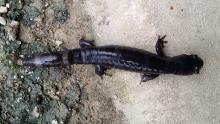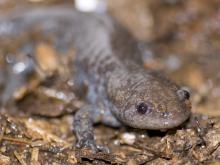Reptiles and Amphibians
Media

Species Types
Scientific Name
Ambystoma opacum
Description
The marbled salamander is a small, stout salamander with silvery, white, or gray saddle-shaped markings on its body from head to tail. They occur in the southeastern half of the state and are seldom encountered except during the autumn breeding season.
Media

Species Types
Scientific Name
Apalone spinifera spinifera
Description
The eastern spiny softshell is a medium to large softshell turtle with small bumps or spines on the front edge of the upper shell. There are dark spots on the fore- and hind limbs.
Media

Species Types
Scientific Name
Ambystoma talpoideum
Description
The mole salamander is broad-headed, dull gray or brown, with a small body and tail and large limbs. It spends almost all its time below ground. In Missouri, it is restricted to the lowlands of our southeastern counties.
Media

Species Types
Scientific Name
Chrysemys dorsalis
Description
The southern painted turtle is small and has a prominent yellow, orange, or red lengthwise stripe down the middle of the upper shell. In Missouri, this aquatic turtle is found only in the Bootheel region.
Media

Species Types
Scientific Name
Storeria dekayi
Description
Dekay's brownsnake is a small, secretive species that prefers moist environments. It can be gray to brown to reddish brown. It usually has a tan stripe running down the back, bordered by two rows of small brown spots. The top of the head is usually dark. Occurs statewide.
See Also
About Reptiles and Amphibians in Missouri
Missouri’s herptiles comprise 43 amphibians and 75 reptiles. Amphibians, including salamanders, toads, and frogs, are vertebrate animals that spend at least part of their life cycle in water. They usually have moist skin, lack scales or claws, and are ectothermal (cold-blooded), so they do not produce their own body heat the way birds and mammals do. Reptiles, including turtles, lizards, and snakes, are also vertebrates, and most are ectothermal, but unlike amphibians, reptiles have dry skin with scales, the ones with legs have claws, and they do not have to live part of their lives in water.





















